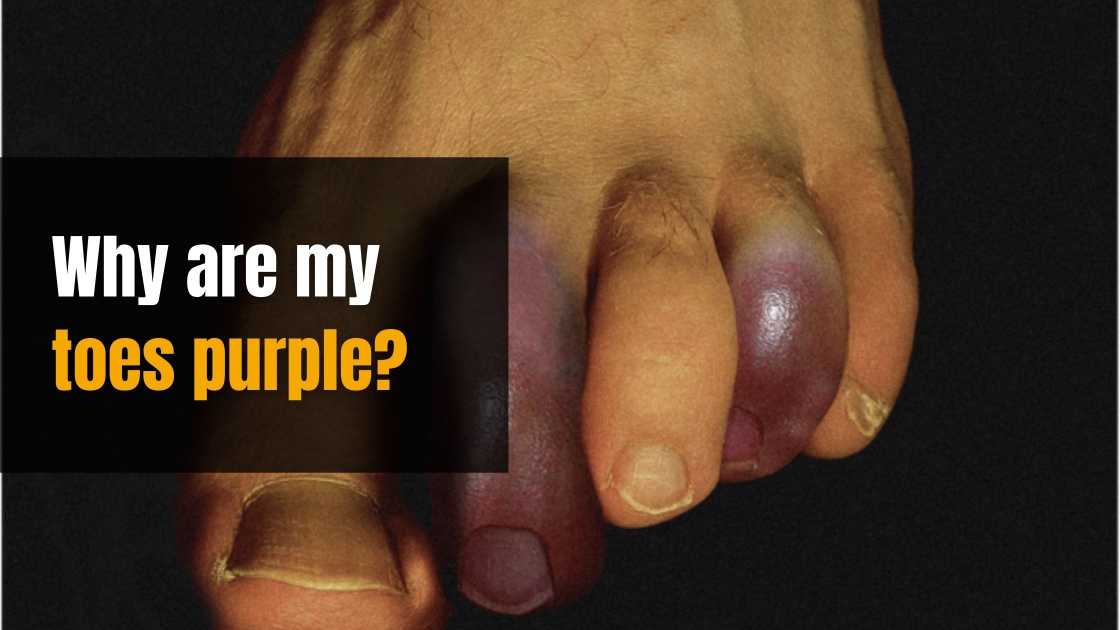Did you just realize that your toes have turned purple or have you had purple toes for a while now? If you are asking yourself “why are my toes purple” then you probably belong to one of the two options mentioned earlier.
Discoloration of your toes or feet may be a sign of poor blood circulation, foot injury, and diabetes amongst others. Such a discoloration may be a temporary bruise or inflamed tissue that may not leave any permanent damage to your toes.
However, there are some other causes of purple toes that can be very serious, and hence you may need to pay close attention to.
As you read on, you will get to know more about exactly what causes your toes to become purple.
What causes my toes to become purple?
The proper flow of blood between your heart and feet can be disrupted by a variety of problems. Your toes become purple because there is a lack of blood flow or impaired blood flow to the toes.
The following are some of the health issues that might impact your feet’s circulation and hence make your toes purple:
Foot injury can cause your toes to become purple
One reason why your toes are purple can be due to a foot injury that you sustained. Bruising can occur as a result of sprains, strains, or dropping anything on the foot, and the skin will appear blue or purple.
Pain and swelling are common side effects of such an injury. Minor foot injuries can be treated by;
- Applying an ice pack to the affected area
- Having enough rest. You should avoid doing unnecessary activities and placing more pressure on the injured foot for extended periods.
- Wrap a bandage around the damaged foot. The bandage should be snug but not so tight that blood circulation is obstructed.
- When feasible, lift the foot using pillows or a footstool.
- Nonsteroidal anti-inflammatory drugs (NSAIDs), such as ibuprofen or aspirin, are available over-the-counter and can help with pain and swelling.
Poor blood circulation can lead to purple toes
Cuts heal quickly and your skin retains its natural color when your circulation in your foot is good. The blood vessels that deliver blood from your heart to your feet are connected by a network of arteries.
Your blood returns to your heart and lungs through veins for extra oxygen and the start of a new round trip. So, if the blood flow or circulation is interrupted, it can result in discoloration resulting in your toes and feet, in general, becoming purple
An ischemic foot could be the reason why your toes are purple
Ischemia is a condition in which healthy blood flow is reduced in one or more arteries. Ischemic foot occurs when your foot does not receive an appropriate supply of oxygen-rich blood.
An accumulation of cholesterol plaque in one of the main arteries delivering blood to your foot might cause ischemia. A blood clot in an artery could possibly be obstructing blood flow.
A puncture wound or forceful trauma can sometimes cause an artery to become damaged. The following are some of the risk factors for ischemic foot:
- Diabetes
- High cholesterol
- High blood pressure
- Obesity
- History of vascular problems
You may experience pain in your feet and lower legs when walking, in addition to your toes and feet turning purple. In severe cases, you may also experience pain while resting.
Controlling your cholesterol, blood pressure, and blood sugar levels is crucial to preventing ischemic foot.
This may necessitate the use of medications, as well as regular exercise and a diet that helps you maintain a healthy weight. You should also quit smoking because it can damage your blood vessels.
Acrocyanosis
Acrocyanosis also affects the healthy blood flow in your feet’s arteries. The term acrocyanosis refers to a bluish coloring of the skin caused by a lack of oxygen to the extremity.
It is frequently brought on by spasms of small blood vessels near the skin’s surface. When an artery spasms, it quickly constricts. The artery’s blood flow might be substantially reduced or even stopped as a result of this temporary tightness.
Acrocyanosis can cause the skin on your hands to turn blue or purple. It’s a non-painful ailment that normally has no other symptoms. Women are also more likely than men to be affected by this illness.
Raynaud’s disease
Raynaud’s illness, also known as Raynaud’s phenomenon, is a common ailment in which the blood arteries in the hands and feet spasm and constrict momentarily. This habit restricts blood flow, causing the affected parts to turn blue, purple, red, or white.
Raynaud’s disease attacks can produce discomfort, numbness, and pins & needles, among other symptoms. A person’s ability to utilize their feet or fingers may be impaired as a result of these attacks.
It is triggered by cold weather, anxiety, and stress. Attacks are usually brief and pass once the person warms up or the stress subsides.
The majority of Raynaud’s instances are minor. Preventing attacks can be as simple as keeping the feet and hands warm and dry during cold weather and reducing stress. A doctor may recommend medicine to help reduce symptoms in those with more severe Raynaud’s.
Raynaud’s syndrome can sometimes be a sign of a more serious ailment, such as lupus or rheumatoid arthritis. Raynaud’s disease symptoms should be checked out by a doctor to rule out other illnesses.
Lupus
Lupus, also known as systemic lupus erythematosus, is an autoimmune disease in which the immune system destroys healthy tissues and organs. Lupus symptoms range in degree and variety, and they can affect many various parts of the body, including the foot.
Extreme weariness, joint pain, and swelling are all common lupus symptoms. Raynaud’s illness affects up to one-third of patients with lupus, according to the Lupus Foundation of America.
Vasculitis, or inflammation of the blood vessels, is a complication of lupus. Vasculitis in the foot can result in a rash that looks like red or purple spots on the skin. This rash can also occur on other body parts. Numbness, tingling, and a loss of strength in the foot are all symptoms of Vasculitis.
Peripheral artery disease
A constriction of the arteries outside the body’s core is known as Peripheral Arterial Disease (PAD). Blood flow to certain parts of the body’s exterior components, such as the limbs, is restricted.
Pain, cramping, tingling, and weakness are common symptoms of PAD, and people may experience these in their legs. Reduced blood flow can cause the legs and feet to progressively become blue or purple.
Some persons with PAD, on the other hand, may not show any signs or symptoms. Anyone experiencing signs of PAD should consult a physician. The disease might worsen without treatment, leading to major complications such as acute ischemia and gangrene.
A doctor may need to amputate a portion of the leg or foot in extreme instances. PAD also raises your chances of developing heart disease, having a heart attack, or having a stroke.
Diabetes
Diabetes is a disease that alters how blood sugar levels are regulated. A high sugar level in the blood can cause a variety of symptoms, including foot difficulties caused by damage to peripheral blood vessels and nerves. Diabetes patients are at a higher risk of getting PAD.
Blood arteries in the legs and feet might become small and rigid if blood sugar levels are out of control. Blood supply to the foot is reduced as a result, which can lead to:
- Infection
- Sores
- Purple coloring of feet
- Nerve damage
- Cold feet
- Pain and cramps
- Numbness
- Slow healing of cuts and wounds
Frostbite
Frostbite is a condition that occurs when the skin and tissues are exposed to extremely cold temperatures. The extremities of the body, such as the hands and feet, are particularly vulnerable to frostbite.
Frostbite symptoms include:
- Pain
- Numbness
- Discoloration of the skin (purple color)
The tissues of the body can be permanently damaged by frostbite. In severe circumstances, a doctor may be forced to amputate the damaged limb.
To avoid frostbite, take the following precautions:
- When going outside in the cold, dress warmly and in layers. When it’s severely cold, wear warm socks and water-resistant boots, and cover any exposed skin.
- If frostbite warnings are issued by local weather officials during the cold months, stay inside.
- When out in the cold, avoid getting your hands or feet wet. If they become wet, take them inside and dry them.
- Check the skin for symptoms of pain, discoloration, or numbness on a regular basis. When youngsters are playing outside in the cold, keep an eye on their skin and make sure they are staying warm and dry.
How to treat toes that have become purple
Treatment of purple toes and feet is usually determined by the cause. Medications or techniques to maintain good circulation are frequently used to address these disorders. A healthy lifestyle and basic preventive steps are sometimes all that are required.
Amputation may be necessary if the damage to your foot’s circulation is serious enough to put your foot tissue at risk of dying.
The takeaway from this article
There are many possible reasons why your toes are purple in color. Bruising after a small injury might cause skin pigmentation. Purple or blue skin, on the other hand, can suggest a limitation in blood flow to the feet, which can be a sign of an underlying health problem.







Leave a Comment